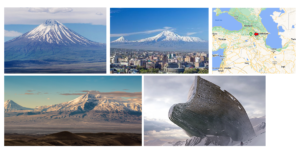“I see it, Donica. Right there at the top.”
“Where, where?”
“To the right, just below the snowline. It’s the ark, honey! It’s definitely the ark!”
That conversation never happened, because 1) My wife, Donica, wasn’t there with me in Turkey 35 years ago (we didn’t even meet until 2012!), and 2) I didn’t actually see Noah’s Ark at the top of Mount Ararat. But I COULD have — or so it seemed at the time.

Even without a precious biblical artifact at it’s peak, Ararat is a beautiful mountain. A dormant volcano, it consists of two major volcanic cones: Greater Ararat and Little Ararat, with the larger cone topping out at 16,854 feet. Interestingly, people have tried to summit the mountain since the Middle Ages, no doubt in the hope of discovering the remains of an ancient boat (and perhaps a pair of giraffe or elephant bones). The first recorded ascent, however, didn’t happen until 1829. Despite lying in Turkey, officially, Ararat is the principal national symbol of Armenia, where it remains a sacred mountain as well as an icon of Armenian irredentism. In fact, it’s even depicted on the coat of arms of Armenia, along with – of course – Noah’s Ark.
Traveling in eastern Turkey is an interesting experience. The scenery is gorgeous. The accommodations are a bit ramshackle. You’ve got borders with some pretty exotic places: Syria, Iran, Armenia and Georgia. When I was there in 1988, Georgia was part of the Soviet Union – meaning there were scary guard towers all around and absolutely no photos allowed unless you wanted to be the focus of target practice. In other words, a journey to this region of the world was a bit of an adventure, and what adventure doesn’t have a sacred mountain with a (potentially) holy relic? Like I said, Ararat is a beautiful mountain and worth a visit. But what makes it special, to me, even more than its natural attractiveness, is its mythology. People around the world have peered at this place for generations, wondering if maybe, just maybe, a celebrated biblical relic might be hiding up high somewhere. The mythology, the hope, the expectation – these all elevate Mount Ararat to Indiana Jones status which, as you know, is like catnip to me. I can never resist a good archeological adventure!
(It’s always the stories that deliver meaning. A bridge is just a bridge – until you learn that a prince proposed to a commoner there, or a rockstar crashed into a guardrail. People are the same way, I think. That punk with the mohawk and the pierced cheeks – yuck! Until, that is, you learn his backstory — that he almost died three times from overdoses, then picked himself up, became a vegan activist and now travels to schools across the country, preaching healthy living. In other words, don’t let external appearance lead to snap judgments. Push to learn the hidden stories. Push for deeper understanding.)
